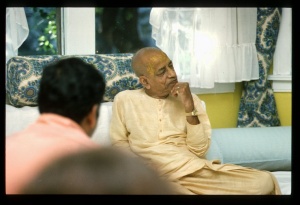SB 2.10.3

A.C. Bhaktivedanta Swami Prabhupada
TEXT 3
- bhūta-mātrendriya-dhiyāṁ
- janma sarga udāhṛtaḥ
- brahmaṇo guṇa-vaiṣamyād
- visargaḥ pauruṣaḥ smṛtaḥ
SYNONYMS
bhūta—the five gross elements (the sky, etc.); mātrā—objects perceived by the senses; indriya—the senses; dhiyām—of the mind; janma—creation; sargaḥ—manifestation; udāhṛtaḥ—is called the creation; brahmaṇaḥ—of Brahmā, the first puruṣa; guṇa-vaiṣamyāt—by interaction of the three modes of nature; visargaḥ—re-creation; pauruṣaḥ—resultant activities; smṛtaḥ—it is so known.
TRANSLATION
The elementary creation of sixteen items of matter—namely the five elements [fire, water, land, air and sky], sound, form, taste, smell, touch, and the eyes, ears, nose, tongue, skin and mind—is known as sarga, whereas subsequent resultant interaction of the modes of material nature is called visarga.
PURPORT
In order to explain the ten divisional symptoms of the Śrīmad-Bhāgavatam, there are seven continuous verses. The first of these under reference pertains to the sixteen elementary manifestations of earth, water, etc., with material ego composed of material intelligence and mind. The subsequent creation is a result of the reactions of the above-mentioned sixteen energies of the first puruṣa, the Mahā-Viṣṇu incarnation of Govinda, as later explained by Brahmā in his treatise Brahma-saṁhitā (BS 5.38) as follows:
- yaḥ kāraṇārṇava-jale bhajati sma yoga-
- nidrām ananta-jagad-aṇḍa-sa-roma-kūpaḥ
- ādhāra-śaktim avalambya parāṁ sva-mūrtiṁ
- govindam ādi-puruṣaṁ tam ahaṁ bhajāmi
The first puruṣa incarnation of Govinda, Lord Kṛṣṇa, known as the Mahā-Viṣṇu, goes into a yoga-nidrā mystic sleep, and the innumerable universes are situated in potency in each and every hair hole of His transcendental body.
As mentioned in the previous verse, śrutena (or with reference to the Vedic conclusions), the creation is made possible from the Supreme Personality of Godhead directly by manifestation of His particular energies. Without such a Vedic reference, the creation appears to be a product of material nature. This conclusion comes from a poor fund of knowledge. From Vedic reference it is concluded that the origin of all energies (namely internal, external and marginal) is the Supreme Personality of Godhead. And as explained hereinbefore, the illusory conclusion is that creation is made by the inert material nature. The Vedic conclusion is transcendental light, whereas the non-Vedic conclusion is material darkness. The internal potency of the Supreme Lord is identical with the Supreme Lord, and the external potency is enlivened in contact with the internal potency. The parts and parcels of the internal potency which react in contact with the external potency are called the marginal potency, or the living entities.
Thus the original creation is directly from the Supreme Personality of Godhead, or Parambrahman, and the secondary creation, as a reactionary result of the original ingredients, is made by Brahmā. Thus the activities of the whole universe are started.